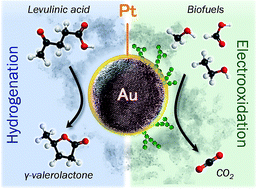Atomically thin Pt shells on Au nanoparticle cores: facile synthesis and efficient synergetic catalysis†
Abstract
We present a facile synthesis protocol for atomically thin platinum (Pt) shells on top of gold (Au) nanoparticles (NPs) (Au@PtNPs) in one pot under mild conditions. The Au@PtNPs exhibited remarkable stability (> 2 years) at room temperature. The synthesis, bimetallic nanostructures and catalytic properties were thoroughly characterized by ultraviolet-visible light spectrophotometry, transmission electron microscopy, nanoparticle tracking analysis and electrochemistry. The 8 ± 2 nm Au@PtNPs contained 24 ± 1 mol% Pt and 76 ± 1 mol% Au corresponding to an atomically thin Pt shell. Electrochemical data clearly show that the active surface is dominated by Pt with a specific surface area above 45 m2 per gram of Pt. Interactions with the Au core increase the activity of the Pt shell by up to 55% and improve catalytic selectivity compared to pure Pt. The Au@Pt NPs show exciting catalytic activity in electrooxidation of sustainable fuels (i.e. formic acid, methanol and ethanol), and selective hydrogenation of benzene derivatives. Especially high activity was achieved for formic acid oxidation, 549 mA (mgPt)−1 (at 0.6 V vs. SCE), which is 3.5 fold higher than a commercial < 5 nm PtNP catalyst. Excellent activity for the direct production of γ-valerolactone, an alternative biofuel/fuel additive, from levulinic acid and methyl levulinate was finally demonstrated.


 Please wait while we load your content...
Please wait while we load your content...